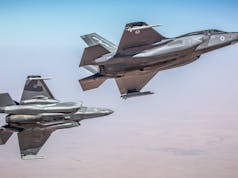On 13 December 2024, Rolls-Royce successfully completed the Critical Design Review (CDR) for its F130 engine, marking a significant milestone in the development of the upgraded B-52J for the U.S. Air Force.
This achievement clears the path for the final stages of development, including testing and production, moving the project closer to delivering the new engines for the long-serving B-52 aircraft.
The CDR milestone follows more than two years of intensive design work, involving close collaboration between Rolls-Royce, the U.S. Air Force, and Boeing. The next step in the program is the commencement of altitude testing in February 2025 at the U.S. Air Force Arnold Engineering Development Complex in Tullahoma, Tennessee.
“We’re extremely proud to have delivered the F130 CDR milestone on-time for the B-52J, and grateful for our continued partnership with the U.S. Air Force and Boeing. Throughout the detailed design phase, our teams have executed a rigorous process in close collaboration with our partners,” said Candice Bineyard, Director of Early Life Cycle & Naval Programs – Defense at Rolls-Royce.
Additionally, Rolls-Royce has completed the first phases of sea-level testing for the F130 engine at its Indianapolis facility, as well as Rapid Twin Pod Tests at NASA Stennis Space Center. These tests have provided crucial performance data and validated the engine’s integration with the B-52J.
Testing at NASA Stennis was particularly significant as it marked the first time F130 engines were tested in the B-52’s dual-pod engine configuration. These tests helped to confirm Rolls-Royce’s predictions and reduce risks associated with the engine’s integration into the aircraft.
The F130 engine, which will be manufactured, assembled, and tested at Rolls-Royce’s largest U.S. production facility in Indianapolis, is expected to significantly enhance the B-52J’s performance, with a focus on reliability and long-term operational capability.














Ah Lisa..working on Christmas day..
Merry Christmas to all.
Perhaps this will finally get rid of the smoke trail for B52’s
AA
Thanks Lisa and Merry Xmas.
Yes be good minus smoke trails for b52s
The existing power plant is very old school.
This will provide greater range through improved economy and increased thrust as well as reducing pollution.
Yep but even more importantly it will should help with availability, lower maintenance costs and reliability. Spares for a 63 year old Turbofan are probably scarce and expensive.
Oh and Merry Xmas 🎅🏻
All true!
Indeed, all the “ilities” have improved metrics, w/ the exception of affordability. Projected cost growth for BUFF re-engining has increased from $12.5B to $15B, FOC now 2033. MIC strikes again. 🤔😳😱☹️
Funny to think we could have done something similar with the V-bombers.
Much harder as the 4 x Olympus were inside the wing. Which lead to a very, very low RCS for such an old design – from certain angles.
It was much more stealthy than is often appreciated.
B52 is nacelle mounted in a new design nacelle so easier to retro engineer.
A321 XLR will only have 2 engines, will be modern, and able to carry many sono boy, torpedoes, bomb and cruise missile. On our side, the warhead of a Cruise missile can be what we want it to be.
B52 is great, but the cell is no longer produced, pilotes need a ton of training, égides are too few. So it is a nice parade asset, but nothing more. A B777, B727, an A321 or an A330/350 are far more serious options. Plenty of pilotes, engines, traines techniciens and pilotes, a strong payload… and astonishing manufacturing capabilities.
You still need to consider payload. A321XLR max payload 56000lbs. B-52 Max Payload 70000lbs which may well increase with the new engines. So yes, as a platform for an MPA the A321 is just fine, as a long range strategic bomber platform…It would definitely come second to the Old Dog.
Hi SB, there is a lovely video on you tube showing the Vulcan Restoration Trust removing an Olympus from their aircraft for maintenance it’s time lapse and has a clock in the bottom left for reference. Apparently with a little time and effort it drops straight out the bottom so as long as the new engine was designed to fit in the same enclosure then it seems it wouldn’t have been all that hard. It makes sense if you think about it. They have to be able to perform an engine swap to maintain aircraft readiness.
I was lucky enough to see the Vulcan fly when she was still operational. It was a school trip in 1980 and we were out in the middle of nowhere walking a ridge line when a Vulcan came down the valley the other way. The cockpit was head height for us and the pilot just waved as he passed us as though he was driving a car. Completely surreal moment but one I still remember vividly well over 40 years later
I remember seeing a Vulcan at Farnborough with one engine slung underneath coming down the runway, they switched off the main engines and flew on the one engine, they continued on the one engine then suddenly did a 90 degree turn straight up. They were using the Vulcan as a test bed for the Concorde engine.